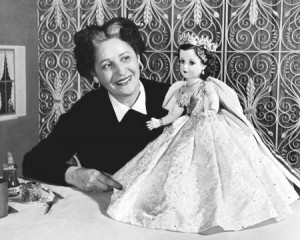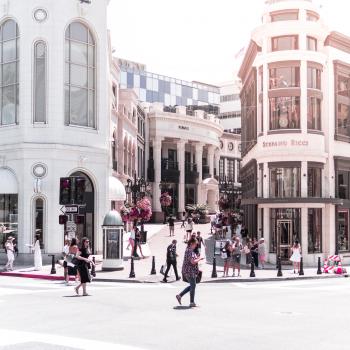 Dave Ramsey, the millionaire evangelical Christian money coach who’s famous for telling his clients they “can’t afford it” and hectoring them to pay their bills in cash, would have thought I had lost my mind.
Dave Ramsey, the millionaire evangelical Christian money coach who’s famous for telling his clients they “can’t afford it” and hectoring them to pay their bills in cash, would have thought I had lost my mind.
And, indeed, it is true that I was aflame with that particularly American form of madness which manifests itself as Having to Shop. The day before I had faced some obstacles peculiar to the American professional workplace, nothing that was all that punishing but was disorienting and exhausting enough—work-life balance, blah blah blah—that the only appropriate remedy was to spend money. I took my five-year-old daughter to the American Girl store in Tyson’s Corner Mall.
This was a matter of some urgency: The dolls Marie-Grace and Cécile had “been retired,” and I was in a race to get at least one of them.
Let us pause now to consider the phenomenon of American Girl dolls in general, premium-priced, but not especially fragile or rare dolls that were once noted for their exceptionally and historically detailed accessories. The line of dolls with accompanying books launched way back at the end of the 1980s, long after my own doll years in the more modest era of the patchwork-clad Holly Hobbie.
What I really always wanted was a Madame Alexander doll (first introduced in the 1920s): tulle-skirted, porcelain-faced with 50s eyebrows and prim rosebud lips, but my mother said that we could not afford one, end of story. And that was just what happened when you asked for something in the 1970s, which is why we now have forty-something mothers like me willing to plunk down $125 on a plastic doll made in China.
The line of American Girl historical characters originally represented a rather narrow and Caucasian understanding of what the term American represented: There was Midwestern Swedish immigrant Kirsten, wealthy Victorian-era Samantha, and middle-class World War II-era Molly, to name a few, who were eventually joined by Native American Kaya, Latina Josefina, and, to much fanfare in the mid-90s, African-American Addie.
At the time, Addie struck me as having the most interesting storyline—with a daring escape to freedom on the Underground Railroad and a reunited family. Furthermore, Addie’s eponymous book collection was authored by Connie Porter, who had a noted debut with her novel-in-stories All Bright Court, about a community of black miners in the North.
By the time I had my own daughter, the American Girl company had been sold to Mattel and sucked up into a veritable consumerist ecstasy, with the original emphasis on historical dolls downplayed in favor of made-to-order dolls designed to look like their young female owners, and the range and cuteness of the available accessories (cheerleading outfits, sports equipment, wheelchairs) overwhelmed historical relevance or accuracy.
Meanwhile, American Girl stories began to pop up in cities around the nation, starting with the New York City flagship store, and with their overpriced bistros and in-house doll hair salons began to seem, by 2008, to be the apogee of Late Capitalism.
This is why I found the 2011 introduction of Marie-Grace and Cécile especially interesting: Set in 1850s New Orleans, the story behind this “friendship pair” is that of the daughter of a white do-gooder doctor newly arrived in the city, Marie-Grace Gardner, who gradually becomes friends with wealthy Creole Cécile Rey, and the two go on to have a variety of learning adventures.
I don’t know any more specifics than what I learned from the blurbs in the catalogues, because my own daughter was too young at that point for the American Girl historical character dolls. But oh how I loved the fact that the stories were set in New Orleans, the city where I’d gone to college for four years, and a complicated place indeed. I loved the costumes with their Empress Eugénie skirts, the mosquito net covered beds, and lacy iron chairs.
And perhaps most of all, I loved the narrative of inter-cultural friendship. In keeping with both the particulars of New Orleans itself and the unspoken complexities of race relations in America, it reached beyond our standard —and greatly separated—narratives of Black and White toward recognition of the new and multiracial America dawning before us.
When I heard during the spring of 2014 that “AG,” as online doll collectors refer to American Girl, had decided to retire Marie-Grace and Cécile entirely as part of a revamped marketing campaign for the historical characters, it occurred to me that perhaps the rest of America had not quite been ready for the new and multiracial America that their introduction had represented.
To begin with, nine years after Hurricane Katrina, Americans still don’t quite know what to make of New Orleans. But underlying even that confusion is the essential shadow that issues of race still cast over American life, the continuum and shared blood, borne of oppression, between us, still unrecognized and un-admitted.
The forced retirement of Marie-Grace and Cécile then, reminded me of nothing less than the original American sin that William Faulkner so beautifully expresses in Absalom, Absalom—when plantation son Henry Sutpen refuses to recognize the humanity of his Creole half-brother, Charles Bon, and kills him instead—and as writer John Jeremiah Sullivan analyzes so beautifully in his introduction to the new Modern Library edition of the novel.
And perhaps I’m not the only one who has felt this way: When we got to the American Girl store we were able to find Marie-Grace dolls and bought one, appropriate for my own dear daughter of do-gooding parents, down to her same shining golden brown hair. But Cécile, the friend, had already sold out and was gone. Rising in price and boosted by her hoarding fans, restored to memory and recognition on E-Bay.
A native of Yazoo City, Mississippi, Caroline Langston is a convert to the Eastern Orthodox Church. She is a widely published writer and essayist, a winner of the Pushcart Prize, and a commentator for NPR’s “All Things Considered.”











